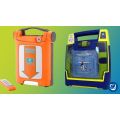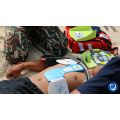How to Tell When Someone Needs CPR
You’re at a restaurant when, suddenly, someone across the room has collapsed. You decide to help and find the person seemingly unconscious. You think they may need CPR, but you aren’t sure. How do you tell when someone needs CPR? Not everyone who is unconscious need CPR so it’s important to know when they need it and how to properly check.
How to know when to perform CPR
There are several symptoms of sudden cardiac arrest. Taking the time to check will only cost a few seconds and confirm that the person should receive CPR. Before starting CPR, ask yourself these questions to make sure the victim needs it.
- Is the victim unconscious? Gently shake the person and call out to them while looking for a response. If there is no response, they have undergone loss of consciousness, a sign of sudden cardiac arrest.
- Is their heart beating? If you can’t hear or feel a heartbeat, their heart has most likely stopped, and CPR should be provided immediately.
- Is the person not breathing or having difficulty breathing? The victim may not be breathing or taking shallow, gasping breaths. If the person is breathing easily, do not provide CPR.
- Does the person have a pulse? Check the victim’s pulse and if you don’t feel a pulse or it feels weak and thready, immediately perform CPR.
How to check for a pulse

One obvious sign that someone has undergone sudden cardiac arrest and needs help is having no pulse or an extremely weak pulse. A pulse measures the number of heart beats in one minute and pulse rates can be different for each person. The normal pulse for children under 18 is 70 to 100 beats per minute (BPM) and adults over 18 is 60 to 100 BPM. However, checking your pulse can sometimes be tricky if you don’t know what you’re looking for.
- Know where the pulse is. Your pulse can be found where arteries are close to the surface of the skin. The simplest place to find one is at the wrist where it’s known as the radial pulse. The second best place to find a pulse is the in the neck. To find the pulse in your neck, put your index and middle fingers in the groove of your neck along your windpipe.
- Check for a pulse. Now that you know where your pulse is located, it’s time to feel for it in your wrist.
- Turn the arm of the victim over so the hand is palm-side up.
- Take your index and middle fingers together and place them on the groove of the forearm.
- Move down the arm until you reach the fold of the wrist. You should feel a pulse just under the base of the thumb.
- If there is no pulse, immediately begin CPR, but not before finding two bystanders and having one of them call 911 while the other looks for an AED.
How to check for breathing

If you don’t feel confident finding the pulse, you can check if the victim is breathing. If they are not breathing or are having extreme difficulty breathing, it’s a strong sign that they need CPR. There a few easy steps to follow that can confirm if the person is breathing.
- Look at their chest. Place your ear over the victim’s mouth and nose, turning your face to look at their chest. Check if the chest is rising or falling at all.
- Listen for breathing from the mouth and nose. While you are checking the chest, you should also be listening for anything breathing sounds coming from the victim.
- Feel for breathing from the mouth and nose. In the same position, move your cheek closer to the nose and mouth to feel for breathing.
What situations require CPR?
CPR should be performed anytime the victim’s breathing or heartbeat has stopped, usually because of a sudden cardiac arrest incident. There are many situations that may require someone to perform CPR.
- Sudden cardiac arrest
- Near drowning
- Suffocation
- Electrical injuries
- Fire and smoke inhalation
All these situations can either cause the heart to stop or the victim to lose consciousness and stop breathing. It’s important to know when unconsciousness can occur so you are ready to help if needed.
How to learn CPR
Even if you know when someone needs CPR, that doesn’t help the victim unless you know how to perform CPR. Many organizations, such as the American Heart Association (AHA) and the American Red Cross, offer CPR classes that can teach you how to perform CPR, use an AED, and even administer basic first aid. The AHA offers fully online, in-person, or blended courses so you can learn the way that you want to. Many classes will use a CPR manikin with compression rate and depth feedback so you can get real-time feedback on your CPR, and use that to perfect your CPR skills.
Shop CPR manikins at WorldPoint Products
At WorldPoint, we know that how you show up matters. 25 years of serving the needs of the CPR Training industry has put us in a unique position and we feel obligated to commit to a goal bigger than ourselves.
We are so excited to introduce you to WorldPoint Products®! Our own line of healthcare training products that simulate real-world people. We look forward to setting a new standard in the industry and improving outcomes for everybody.
The world’s first ever 3-in-1 CPR training manikin – adult male, adult female, and child – is now up for pre-order on WorldPointProducts.com! Join our pre-order list today!
Have any questions?
 Chat with us on our website, www.worldpoint.com, send us an email at customersolutions@worldpoint.com, or give us a call at 888-322-8350. We look forward to answering all your questions!
Chat with us on our website, www.worldpoint.com, send us an email at customersolutions@worldpoint.com, or give us a call at 888-322-8350. We look forward to answering all your questions!







